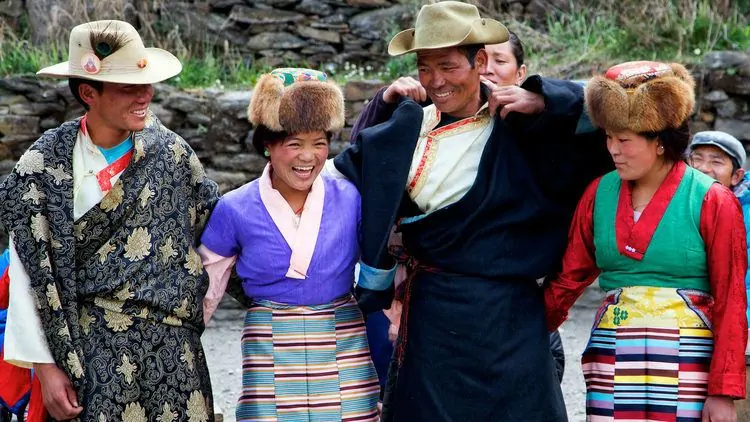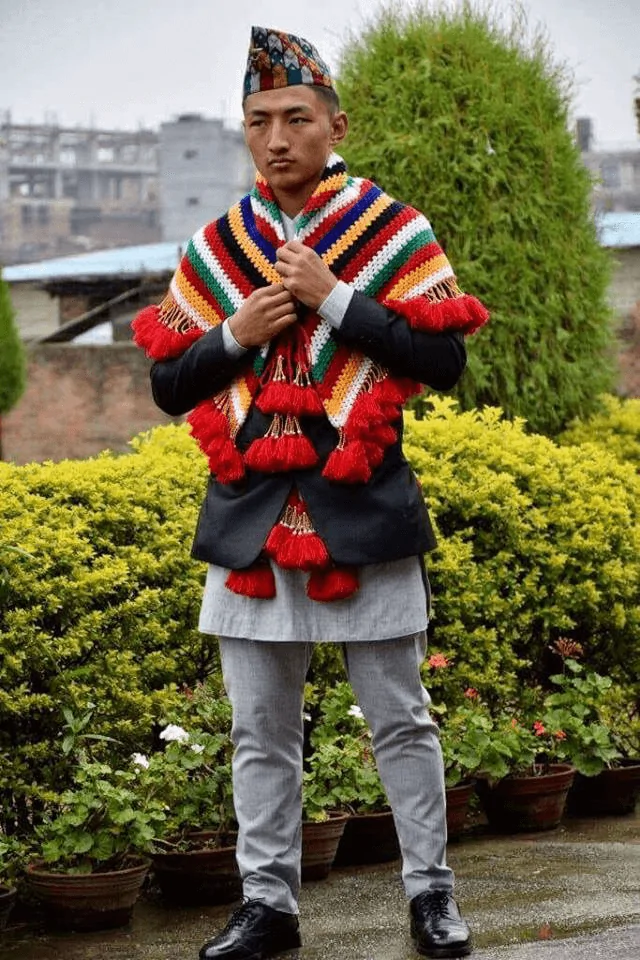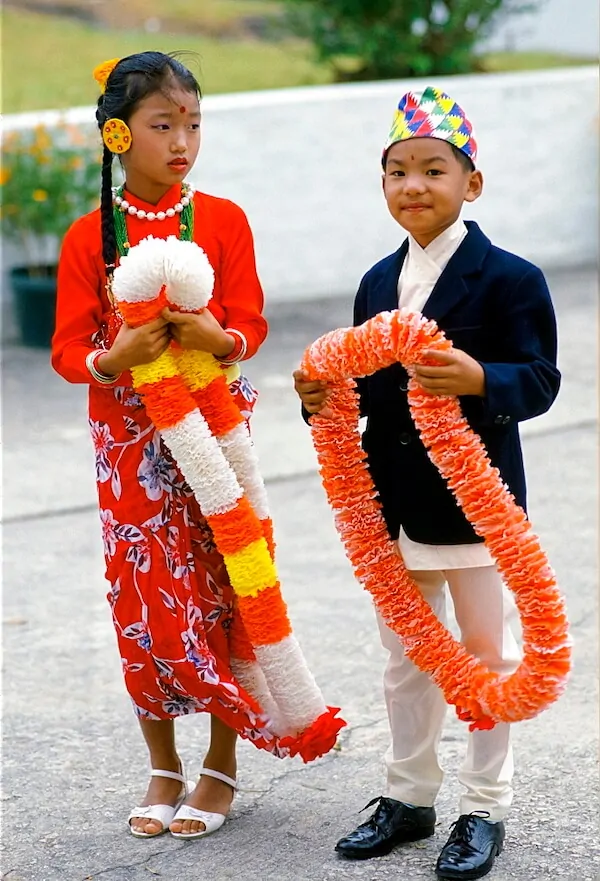Clothing
Nepali Traditional Dresses: The Story of Diversity
Nepal is a diverse country with a wide range of cultural settlements. The Nepalese people remain deeply rooted in ancient old traditions and customs. You can find various Nepalese traditional dresses based on caste and ethnicity. However, Daura Suruwal and Gunyu Cholo are the national dress of Nepal and get worn by Nepalese of all sections, class, and ethnicity.
Nepalese men wear Daura Suruwal with Dhaka Topi, and the women wear Gunyu Cholo. Government Officials and others use this traditional dress on important events and festive occasions. However, ‘Gunyu Cholo,’ has lost its relevance in modern times as Sari is a favorite among the ladies.
Moreover, Nepal has diversity in religions, ethnicity, and castes. The unique culture of the country has more than 100 ethnic groups and 90 spoken languages. These various communities have different outfits and dresses. Other factors like the demography, geographical location, and lifestyle of their ancestors also determine the traditional dress in Nepal.

Furthermore, the Newar community have their own dress called the “Haku Patasi” whereas the Sherpa people have “Bakkhu”.

Similarly, other communities like Rai, Magar, Tamang, and others have their own traditional dress. These dresses along with Daura Suruwal, Dhaka topi, and Gunyo Cholo are available in a regular clothes shop.
Read further to know more about the Nepali Traditional dress and other information in detail.
Nepali Traditional Dress for Men
Daura Suruwal

Daura Suruwal is the men’s national dress of Nepal and is also known as ‘Labeda Suruwal.’ The dress has immense historical and cultural significance. ‘Daura’ is the upper body wear, whereas the ‘Suruwal’ is the trouser. However, the difficulty and complexity of the daura suruwal has made it less relevant in modern times. Hence, western garments gained prominence in Nepal.
Moreover, there are no clasps or buttons in the “Daura”. You have to tie two ties along the waist and two ties near the shoulders. The suruwal part is generally a loose and baggy pair of trousers, and that fits tightly around the ankles. The natural fabric made of Daura is comfortable and warm.
Furthermore, Daura consists of eight strings to tie itself, known as Astamatrika Singini. The Astamatrika Singini refers to the eight goddesses, namely Byagini, Barahi, Kumari, Brahmayani, Maheswari, Byasnabi, Indrayani, and Mahalaxmi. Eight is a pious number in Nepalese mythology.
Besides that, the Daura has five folds in the garment fabric, which refers to the Pancha Ratna Buddha. The round neck denotes the snake god around the neck of Lord Shiva. On festive occasions, you can observe many older people wearing this traditional dress in Nepal.
Historical Significance of Daura Suruwal
One of the historical significance of this dress is that the then prime minister Jung Bahadur Rana wore Daura Suruwal to his official visit to the United Kingdom in the 19th century. This brought the prominence in the use of the dress in Nepal. Jung Bahadur Rana also introduced the use of a coat above the Daura. The Queen of England gifted the coat, and hence the custom of wearing the coat started.
Dhaka Topi

Dhaka Topi is a traditional headwear among Nepalese and is generally worn with the Daura Suruwal. The Dhaka Topi is similar to the brimless cap. Nepalese officials use it on various festive occasions and official events. King Mahendra, who ruled from 1955 to 1972 made Daura Suruwal a traditional dress code of Nepal for government events.
Dhakaptopi is generally worn alongside Daura Suruwal. The pattern on the cap has the material or fabric of “Dhaka.” There are various designs of the cap as well. This headgear also has the Nepali symbol of “Khukuri”. Many Nepali ethnic groups have adopted this headwear as a symbol of national unity.
Dhoti and Lungi

Daura Suruwal is still very popular but is only used on special occasions such as weddings, festivals, ceremonies, and others. For daily life use in humid area in Terai, the Nepali people use other garments like a “lungi”, “dhoti”, “tapalan”, and regular pants as well.
Moreover, the Tapalan consists of a long shirt, tight-fitting pants, a waistcoat, and a topi. Lungi is a rectangular piece of cloth wrapped around a man’s hips. Dhoti is the cloth knotted at the waist while lungi is sewn together at the end.
Nepali Traditional Dress for Women
Gunyu Cholo

Gunyu Cholo is the national dress of the females in Nepal. The traditional Nepalese dress of Gunyo Cholo has a blouse like top and skirt below. Gunyu Cholo is mostly used as an informal dress, and saris are primarily used on formal occasions.
The “Gunyu Cholo” is also a ceremony where the children given to a girl at the age of around 7 or 8, which signifies the transition period from a young girl to a woman. The different ethnic community has their variations of the dress.
Kurta Suruwal

Nepali women also wear “Kurta Suruwal.” The Kurta Suruwal consists of light baggy pants, a blouse, and a large scarf. Nepali women mostly wear this dress in daily life. The Light Baggy Pants are usually in cotton and bright in colors. Different patterns, prints and color gets added for decoration.
Blouse

The blouse is bright-colored with various patterns and prints. The scarf gets draped over the body and the pattern matches with the blouse.
Sari

Sari is a traditional costume and also a wedding dress of Nepalese women. Nepalese sari is similar to Indian sari and consists of “parkar,” petticoat, and a cropped blouse. Sari cloth gets draped around the woman’s waist and across the shoulder. It gets matched with precious jewelry and gold jewels.
Children’s Traditional Dress in Nepal

Children’s clothes are bright in color with various patterns. Small girls wear ankle-length, tightly fitting dresses with long sleeves. They get divided with ease for making it more comfortable with ease.
Moreover, silk or cotton fabric is made with a lot of patterns. These exclusive dresses are mainly worn at festivals. Nepali kids have a lot of piercing and jewelry to protect them from evils.
Various Ethnic Dresses in Nepal

There are more than 100 different castes and ethnicities in Nepal. There are different ethnic dresses and jewelry of these various ethnicities in Nepal. These traditional dresses in Nepal have a history of their own and are quite different from each other. You can find different dresses of Gurung, Rai, Limbu, Newar, Magar, Tharu, Raute, and other ethnic groups.
Overall, the Nepali Traditional dress is a unique part of the Nepalese culture. These dresses are quite important, culturally, and religiously. You can shop for these various traditional dresses in the clothes shops around Kathmandu and other parts of the country. You can purchase this piece of heritage as a souvenir from this beautiful country.

